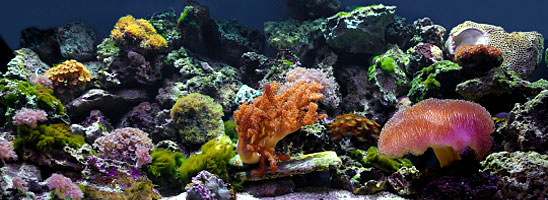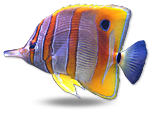
Reef Aquarium Lighting
The choice of lighting for a reef tank will have a significant impact upon coral growth and coloration.
When selecting a lighting system for a reef aquarium, the main factors to consider are:
- Light Intensity
- Spectrum
- Tank Inhabitants
Light Intensity

The intensity of the light depends upon the type and wattage of lighting, depth of the tank, and distance of light source from the water surface. Metal halide lighting will penetrate the water deeper than fluorescents will.
Fluorescent light intensity degrades quickly as distance to the water surface increases, and therefore should be placed as close to the water surface as possible.
Two factors should be considered when determining metal halide lamp distance to the water surface: the first is heat transfer, and the second is the possibility of water splashing on the bulb causing it to explode.
A splash shield is recommended for all metal halide lamps. A ventilated lighting system with a splash shield would allow the metal halide bulbs to be safely placed as close as possible to the water surface with minimal heat transfer.
Spectrum

In order to begin to understand the available spectrum choices of lamps suitable for aquarium use, we must first analyze how light naturally penetrates water. Red light is the first to be filtered out and can only penetrate a short distance. As light waves penetrate deeper into the water, orange and yellow are lost next. Of all the colors of the spectrum blue light penetrates the deepest.
Light spectrum is measured by the Kelvin scale. Natural sunlight on a clear day registers at 5500 Kelvin degrees. Kelvin temperatures less than 5500 become more red and yellow and the higher the Kelvin temperature the more blue the light is. Photosynthetic invertebrates should be kept under lamps rated at or near the Kelvin temperature where the invertebrate was collected. Shallow water species should be kept under 10000K lamps while deep water species would prefer 20000K lighting. Longer photoperiods will not compensate for incorrect light spectrum or intensity.
Actinic Lighting

Actinic lighting peaks in the 420 nanometer range and emits a fluorescent blue light and is usually used as supplemental lighting. Not only is actinic lighting beneficial to photosynthetic invertebrates, it is also aesthetically pleasing to the eye when used to supplement daylight lighting.
As a general rule of thumb, actinic supplementation should be used with 10K metal halide lighting but is not necessary with 20K.
Refugium Lighting
Refugium plants benefit from lighting with a Kelvin temperature in the range of 5500 - 6500 degrees.
Coral Species Light Requirement Chart
| Species | Intensity | Water Column |
|---|---|---|
| SPS Corals | High | Upper |
| LPS Corals | Moderate-High | Middle |
| Soft Corals | Low-Moderate | Lower |
| Corallimorpharians | Low-Moderate | Lower |
| Anemones | Low-Moderate | Sandbed |
| Zoanthids | Low-Moderate | Lower |

